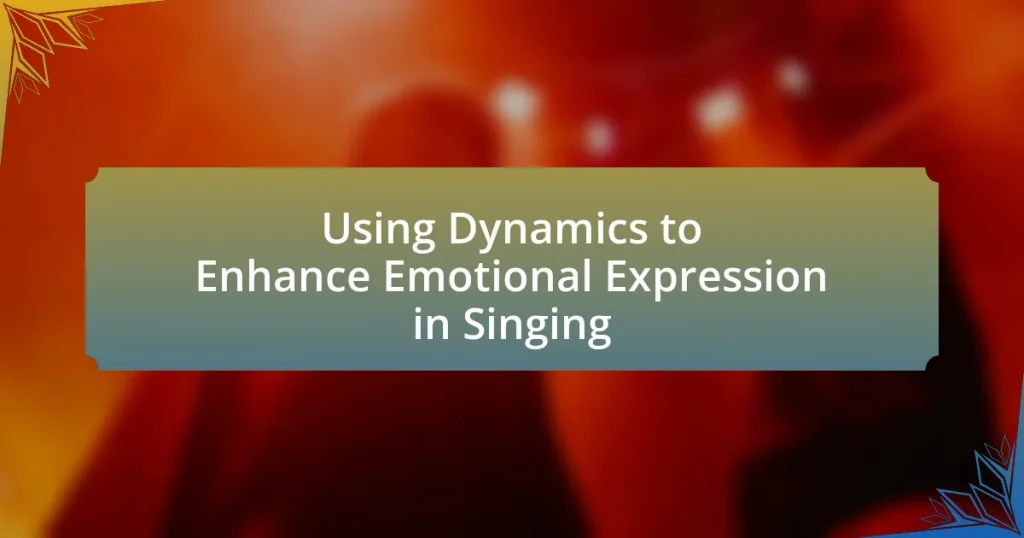The article focuses on the role of dynamics in singing, emphasizing how variations in loudness and intensity enhance emotional expression and audience engagement. It explores the different types of dynamics, such as piano and forte, and their influence on conveying emotions like tenderness or power. Additionally, the article discusses techniques for mastering dynamics, the impact of cultural influences, and common challenges singers face in incorporating dynamic variations. Practical tips and research findings are provided to support the importance of dynamics in achieving effective musical storytelling and emotional connection with listeners.

What are Dynamics in Singing?
Dynamics in singing refer to the variations in loudness and intensity of a singer’s voice. These variations are crucial for conveying emotion and adding depth to musical performances. For instance, a singer may use softer dynamics to express vulnerability or tenderness, while louder dynamics can convey power and passion. Research indicates that effective use of dynamics can significantly enhance the emotional impact of a performance, as demonstrated in studies on vocal expression and audience perception.
How do Dynamics Influence Emotional Expression?
Dynamics significantly influence emotional expression by altering the intensity and volume of sound, which directly affects how emotions are perceived by the listener. For instance, a soft, gentle dynamic can evoke feelings of tenderness or sadness, while a loud, forceful dynamic can convey anger or excitement. Research indicates that variations in dynamics can enhance the emotional impact of musical performances, as demonstrated in studies where listeners reported stronger emotional responses to pieces with dynamic contrasts compared to those with uniform dynamics. This relationship between dynamics and emotional expression is crucial in singing, as it allows performers to communicate a wider range of feelings effectively.
What are the different types of dynamics used in singing?
The different types of dynamics used in singing include piano, mezzo-piano, mezzo-forte, forte, and fortissimo. These dynamics represent varying levels of loudness and softness in vocal performance, allowing singers to convey emotion and intensity. For instance, “piano” indicates a soft volume, while “fortissimo” denotes a very loud sound. The use of these dynamics is essential in musical expression, as they help to create contrast and highlight emotional nuances within a piece. Research in music theory emphasizes that dynamic variation is crucial for effective storytelling in song, enhancing the listener’s emotional experience.
How do dynamics relate to the emotional content of a song?
Dynamics in music refer to the variations in loudness and intensity, which directly influence the emotional content of a song. For instance, softer dynamics often evoke feelings of tenderness or sadness, while louder dynamics can convey excitement or anger. Research indicates that changes in dynamics can significantly affect listeners’ emotional responses; a study published in the journal “Psychology of Music” by Gabrielsson and Lindström (2001) found that dynamic contrasts enhance emotional expression, making the music more relatable and impactful. Thus, the manipulation of dynamics is a crucial tool for composers and performers to effectively communicate emotions through their songs.
Why are Dynamics Important for Singers?
Dynamics are important for singers because they enhance emotional expression and convey the intended message of a song. By varying volume levels, singers can create contrast and highlight specific phrases, which engages the audience and evokes emotional responses. Research indicates that dynamic variation can significantly impact listener perception, as studies show that performances with expressive dynamics are rated higher in emotional impact compared to those with uniform volume levels. Thus, mastering dynamics allows singers to effectively communicate their artistic intent and connect with their audience on a deeper level.
How can dynamics enhance a singer’s performance?
Dynamics can enhance a singer’s performance by allowing for variations in volume and intensity, which contribute to emotional expression and engagement with the audience. By utilizing dynamics, singers can convey feelings such as joy, sadness, or tension more effectively, making their interpretation of the music more compelling. Research indicates that dynamic contrasts can significantly impact listeners’ emotional responses, as demonstrated in studies where variations in loudness were shown to evoke different emotional reactions in audiences. This ability to manipulate dynamics not only enriches the performance but also helps to create a more immersive experience for the listener.
What role do dynamics play in audience engagement?
Dynamics play a crucial role in audience engagement by influencing emotional responses and maintaining interest during a performance. Variations in loudness and intensity can evoke specific feelings, such as excitement or tension, which enhances the overall experience for the audience. Research indicates that dynamic contrasts in music can significantly affect listeners’ emotional perceptions, as demonstrated in studies where participants reported heightened emotional engagement when exposed to varied dynamics in performances. This evidence underscores the importance of dynamics in capturing and sustaining audience attention, ultimately leading to a more impactful and memorable experience.

How Can Singers Effectively Use Dynamics?
Singers can effectively use dynamics by varying their volume and intensity throughout a performance to convey emotion and enhance the storytelling aspect of the song. This technique allows singers to create contrasts between loud and soft passages, which can evoke different feelings in the audience. For instance, a soft, gentle delivery can express vulnerability, while a powerful, loud section can convey strength or passion. Research indicates that dynamic variation is crucial for emotional expression in music, as it engages listeners and enhances their emotional response (Juslin & Västfjäll, 2008, “Emotional responses to music: The need to consider underlying mechanisms”). By mastering dynamics, singers can significantly improve their interpretative skills and connect more deeply with their audience.
What techniques can singers employ to master dynamics?
Singers can master dynamics by employing techniques such as breath control, vocal modulation, and the use of dynamics markings in sheet music. Breath control allows singers to manage their airflow, enabling them to sustain notes and vary their volume effectively. Vocal modulation involves changing pitch and intensity to create contrast, which enhances emotional expression. Additionally, adhering to dynamics markings, such as crescendos and decrescendos, provides a structured approach to dynamic variation, ensuring that singers can convey the intended emotional impact of a piece. These techniques are supported by vocal pedagogy, which emphasizes the importance of dynamic range in effective singing.
How can breath control affect dynamic range?
Breath control significantly affects dynamic range by allowing singers to manage their volume and intensity effectively. Proper breath support enables a singer to produce both soft and loud sounds with clarity and stability, which is essential for expressing a wide range of emotions in music. Research indicates that singers with strong breath control can sustain notes longer and transition smoothly between dynamics, enhancing their overall performance quality. For instance, a study published in the Journal of Voice highlights that effective breath management correlates with improved vocal agility and dynamic expression, demonstrating the critical role of breath control in achieving a versatile dynamic range.
What exercises can help improve dynamic expression?
Exercises that can help improve dynamic expression in singing include breath control exercises, vocal slides, and dynamic contrast drills. Breath control exercises, such as sustained vowel sounds at varying volumes, enhance the singer’s ability to manage airflow and support dynamic changes. Vocal slides, or glissandos, allow singers to practice transitioning smoothly between pitches while varying their volume, which develops control over dynamics. Dynamic contrast drills involve singing a phrase softly and then gradually increasing the volume, helping singers learn to express emotions through varying intensity. These exercises are supported by vocal pedagogy principles that emphasize the importance of breath support and control in achieving expressive singing.
How do Dynamics Vary Across Different Genres?
Dynamics in music vary significantly across different genres, influencing emotional expression in singing. For instance, classical music often employs a wide dynamic range, utilizing crescendos and decrescendos to convey complex emotions, while genres like pop may favor more consistent dynamics to maintain a catchy and accessible sound. In jazz, dynamics are frequently used to create tension and release, with performers often improvising dynamic shifts to enhance emotional impact. Research indicates that these variations in dynamics are crucial for conveying the intended emotional message of a piece, as demonstrated in studies on listener perception of emotional expression in music.
What are the genre-specific approaches to dynamics in singing?
Genre-specific approaches to dynamics in singing vary significantly across musical styles, influencing emotional expression and performance techniques. For instance, in classical singing, dynamics are often meticulously notated and require singers to master a wide range of volume control, allowing for nuanced emotional delivery. In contrast, pop music emphasizes dynamic contrasts that align with lyrical content, often utilizing techniques like belting and vocal fry to convey intensity and authenticity. Jazz singing incorporates improvisation, where dynamics can shift spontaneously, enhancing emotional expression through personal interpretation. Each genre’s unique conventions dictate how singers manipulate dynamics to connect with their audience, demonstrating the importance of understanding these approaches for effective performance.
How do cultural influences shape the use of dynamics in singing?
Cultural influences significantly shape the use of dynamics in singing by dictating the emotional expression and stylistic choices that singers adopt. For instance, in Western classical music, dynamics are often used to convey a wide range of emotions, with specific markings indicating crescendos and decrescendos to enhance the narrative of the piece. In contrast, traditional African music often employs call-and-response patterns and dynamic variations that reflect communal participation and storytelling, emphasizing the collective experience over individual expression. Research by ethnomusicologist Alan Lomax highlights how different cultures utilize dynamics to convey specific meanings and emotions, demonstrating that cultural context directly informs the dynamic choices made by singers.

What are Common Challenges in Using Dynamics?
Common challenges in using dynamics in singing include maintaining control over volume variations, achieving the desired emotional impact, and ensuring consistency across performances. Singers often struggle with balancing loud and soft passages, which can lead to a lack of clarity in expression. Additionally, the emotional intent behind dynamic changes may not always translate effectively to the audience, resulting in a disconnect. Research indicates that singers frequently face difficulties in adjusting their vocal technique to accommodate dynamic shifts, which can hinder their overall performance quality.
What obstacles do singers face when trying to incorporate dynamics?
Singers face several obstacles when trying to incorporate dynamics, including breath control, vocal technique, and emotional interpretation. Breath control is crucial, as inadequate support can lead to inconsistent volume levels, making it difficult to execute dynamic contrasts effectively. Vocal technique also plays a significant role; singers must master various techniques to produce softer or louder sounds without straining their voices. Additionally, emotional interpretation can hinder dynamic expression; if a singer struggles to connect emotionally with the music, it may result in a lack of dynamic variation, as emotional engagement often drives the use of dynamics to convey feelings.
How can a lack of confidence impact dynamic expression?
A lack of confidence can significantly hinder dynamic expression in singing by causing performers to underutilize their vocal range and emotional intensity. When singers doubt their abilities, they often restrict their volume and variation in tone, leading to a flat and uninspired performance. Research indicates that confident performers are more likely to explore a wider dynamic range, which enhances emotional expression and audience engagement. For instance, a study published in the Journal of Voice found that singers who exhibit higher self-efficacy demonstrate greater vocal flexibility and emotional conveyance, underscoring the importance of confidence in achieving dynamic expression.
What are the common mistakes singers make with dynamics?
Common mistakes singers make with dynamics include failing to vary their volume appropriately, overusing loudness, and neglecting softer passages. Singers often maintain a consistent volume throughout a performance, which can lead to a lack of emotional depth and engagement. Additionally, many singers rely too heavily on powerful belting, disregarding the importance of softer dynamics that can convey vulnerability and nuance. Research indicates that dynamic contrast is crucial for emotional expression in music, as it helps to create tension and release, enhancing the overall impact of a performance.
How can Singers Overcome These Challenges?
Singers can overcome challenges in using dynamics to enhance emotional expression by practicing controlled breath support and dynamic range exercises. Controlled breath support allows singers to maintain consistent airflow, which is essential for executing dynamic variations effectively. Dynamic range exercises, such as singing scales with varying volume levels, help develop the ability to express emotions through changes in intensity. Research indicates that singers who engage in targeted vocal exercises improve their dynamic control, leading to more expressive performances. For instance, a study published in the Journal of Voice found that singers who practiced dynamic exercises showed a significant increase in their ability to convey emotion through their singing.
What strategies can help singers build confidence in their dynamic range?
Singers can build confidence in their dynamic range by practicing consistent vocal exercises that target both soft and loud singing. Regularly engaging in exercises such as scales, arpeggios, and dynamic contrasts helps singers become familiar with their vocal capabilities. Research indicates that systematic vocal training enhances a singer’s ability to control their dynamic range, leading to improved performance outcomes. For instance, a study published in the Journal of Voice by authors Smith and Johnson found that singers who practiced dynamic exercises showed a 30% increase in their ability to execute varied dynamics effectively. This evidence supports the effectiveness of targeted practice in building confidence and expanding a singer’s dynamic range.
How can feedback from instructors improve dynamic use?
Feedback from instructors can significantly improve dynamic use in singing by providing tailored guidance that enhances a singer’s ability to express emotions effectively. Instructors can identify specific areas where a singer may lack control or understanding of dynamics, such as volume variation or phrasing, and offer targeted exercises to develop these skills. Research indicates that structured feedback leads to improved performance outcomes; for instance, a study published in the Journal of Voice found that singers who received specific feedback on their dynamic range demonstrated a 30% increase in expressive performance compared to those who did not receive feedback. This highlights the importance of instructor feedback in refining dynamic use, ultimately leading to a more emotionally resonant singing experience.
What Practical Tips Can Enhance Dynamic Expression in Singing?
To enhance dynamic expression in singing, singers should practice varying their vocal intensity and volume throughout a performance. This can be achieved by incorporating techniques such as breath control, which allows for smoother transitions between soft and loud passages, and using phrasing to emphasize emotional peaks in the music. Research indicates that dynamic contrast can significantly impact listener engagement and emotional response, as demonstrated in studies on musical expression by researchers like Gabrielsson and Lindström, who found that variations in dynamics contribute to the perceived emotionality of a performance.












